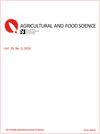Fifth survey on weed flora in spring cereals in Finland
IF 1.1
4区 农林科学
Q3 AGRICULTURE, MULTIDISCIPLINARY
引用次数: 2
Abstract
Regular weed surveys provide information on changes in weed communities. The composition of weed flora in spring cereal fields was investigated in southern and central Finland during 2020–2022. The survey was conducted in 16 regions, 226 farms and 549 fields. The occurrence of weeds was assessed in the second half of July from 90 organically cropped and 459 conventionally cropped fields. The weed flora was dominated by broad-leaved species, representing 81% of the total number of 138 identified species. The average species number per field was 21 in organic fields and 12 in conventional fields. The most frequent weed species in organic fields were Chenopodium album 99%, Erysimum cheiranthoides 84%, Viola arvensis 83% and Stellaria media 82%. In conventionally cropped fields, the most frequent species were Viola arvensis 83%, Stellaria media 65%, Galeopsis spp. 59% and Galium spurium 59%. The two most common grass species in both production systems were Poa annua and Elymus repens. The frequency and density of Poa annua had increased substantially in conventional cropping since the previous survey in 2007–2009. The average density of weeds was 384 plants m-2 in organic fields and 147 plants m-2 in sprayed conventional fields. The average air-dry biomass of weeds was 678 kg ha-1 and 151 kg ha-1, respectively. Elymus repens produced almost a quarter of the total weed biomass in both production systems. Changes in weed flora were minor in terms of frequency and density of the most common broad-leaved weed species. Increased infestation of Poa annua in conventional cropping calls for special attention. The dominance of Elymus repens decreased in both production systems since the previous survey.芬兰春季谷物杂草区系的第五次调查
定期的杂草调查提供了杂草群落变化的信息。对2020-2022年芬兰南部和中部春粮田杂草区系组成进行了调查。该调查在16个地区、226个农场和549个农田进行。7月下半月对90块有机农田和459块常规农田的杂草发生情况进行了评估。杂草区系以阔叶植物为主,占138种杂草总数的81%。有机农田的平均种数为21种,常规农田的平均种数为12种。有机田中最常见的杂草种类为藜草(Chenopodium album) 99%、丹参(Erysimum cheiranthoides) 84%、堇菜(Viola arvensis) 83%和生参(Stellaria media) 82%。在常规农田中,最常见的种为紫堇(Viola arvensis) 83%、生藤(Stellaria mediaria) 65%、Galeopsis spp. 59%和樱草(Galeopsis spp. 59%)。两种生产系统中最常见的两种草是年草和羊草。自上次2007-2009年的调查以来,常规种植中每年发生Poa的频率和密度大幅增加。有机田平均杂草密度为384株m-2,喷药常规田为147株m-2。杂草的平均风干生物量分别为678 kg ha-1和151 kg ha-1。在两种生产系统中,赖草产生的杂草生物量几乎占总生物量的四分之一。在最常见的阔叶杂草种类的频率和密度方面,杂草区系的变化较小。在常规种植中,年虫的危害增加,需要特别注意。自上次调查以来,羊草在两个生产系统中的优势度都有所下降。
本文章由计算机程序翻译,如有差异,请以英文原文为准。
求助全文
约1分钟内获得全文
求助全文
来源期刊

Agricultural and Food Science
农林科学-农业综合
CiteScore
2.50
自引率
0.00%
发文量
22
审稿时长
>36 weeks
期刊介绍:
Agricultural and Food Science (AFSci) publishes original research reports on agriculture and food research related to primary production and which have a northern dimension. The fields within the scope of the journal include agricultural economics, agricultural engineering, animal science, environmental science, horticulture, plant and soil science and primary production-related food science. Papers covering both basic and applied research are welcome.
AFSci is published by the Scientific Agricultural Society of Finland. AFSci, former The Journal of the Scientific Agricultural Society of Finland, has been published regularly since 1928. Alongside the printed version, online publishing began in 2000. Since the year 2010 Agricultural and Food Science has only been available online as an Open Access journal, provided to the user free of charge. Full texts are available online from 1945 on.
 求助内容:
求助内容: 应助结果提醒方式:
应助结果提醒方式:


